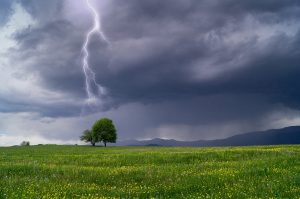Weather Conditions That Make Water Emergencies More Likely
 Spring is a wonderful season. Birds are singing, trees are blooming, and flowers are popping up everywhere. The skies are blue, the grass is green, the air is warm and breezy, and everything is perfect. Well, not everything. The warmer weather can bring extensive rain and turbulent storms, which unfortunately can cause flooding in your home. But not all storms present the same threat of flooding. There are some specific circumstances that should cause you to be on the watch for water emergencies caused by storms.
Spring is a wonderful season. Birds are singing, trees are blooming, and flowers are popping up everywhere. The skies are blue, the grass is green, the air is warm and breezy, and everything is perfect. Well, not everything. The warmer weather can bring extensive rain and turbulent storms, which unfortunately can cause flooding in your home. But not all storms present the same threat of flooding. There are some specific circumstances that should cause you to be on the watch for water emergencies caused by storms.
Extended Stretch of Rainy Days
A single rainy day or fleeting spring storm does not hold a great danger of flooding. The ground can easily absorb and filter the small amount of precipitation produced. However, rain that continues day after day (as it can in the spring) is harder to deal with. Without a break, the ground becomes saturated. After saturation, the ground cannot hold any more water. Instead, rain will simply pool on the surface of the soil. This water runs off into creeks and streams, which swell and eventually overrun their banks. As smaller waterways flow into larger rivers, the amount of misplaced water grows. This uncontained water is more likely to find its way into your home.
Heavy Downpours in a Short Time
Similar saturation can also occur when rain is unusually heavy. In this case, it doesn’t take days for flood conditions to develop, but rather hours. If the pace of the rain is too quick for the ground to absorb, water will begin running off almost immediately. Ground saturation can be worsened by the thawing of ground ice. In early spring, this phenomenon is more common. Flooding in this situation can cause more damage because the flooding occurs so quickly. There is little time to prepare for the rapid worsening of conditions.
Fast-Moving Water
Another situation that increases the likelihood of flooding and damage is one that involves water that is moving quickly. Whether the rain is heavy and sudden or steady and prolonged, a complication that can appear is quick-flowing water. This can be caused by a breach in a dam or levee. It could also be caused by a landscape with drastic changes in elevation. For this reason, you should know as much as you can about the ground surrounding your house. If there is a potential for water that could pick up speed as it flows, you’ll want to take steps to reinforce any doors or windows that could be broken by powerful channels of water.
Storm-Damaged Power Lines
Another condition that can add to the threat of flooding during spring storms is the disruption of electrical service. Lightning or winds can take down power lines or even destroy the structure of poles and wires that deliver electricity. Beyond just being an inconvenience, the absence of electricity also makes sump-pumps useless. Without a source of electricity, many basements are defenseless against the water that seeps or flows into them. This is a good reason to invest in a back-up sump-pump that runs with energy from a battery or a generator.
In life, we have to take the good with the bad. This is true of spring too. With the fresh, warm air and the colorful, fragrant flowers, we must also take the rainy days that can so easily lead to flooding. The best strategy for dealing with floods is to be as prepared as possible and then keep Langenwalter’s number close by for the emergency water situations you may encounter. Call us at 317-876-9944 anytime day or night, and we will get our expert water remediation crew dispatched right away.






 4521 W. 99th Street Carmel, IN 46032
4521 W. 99th Street Carmel, IN 46032